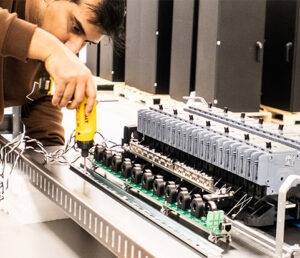The cryptomining industry has expanded into a substantial business enterprise because digital currencies such as Bitcoin and Ethereum among others have achieved widespread adoption. The mining operation requires substantial energy consumption to maintain its function with dependable crypto power facilities. Crypto power infrastructure requires increasing attention because cryptocurrency demand continues to grow. This blog investigates the role of crypto power infrastructure in cryptocurrency mining through exploration of its fundamental support to the industry’s current and future growth.
What is Crypto Power Infrastructure?
The initial segment requires a definition of the crypto power infrastructure which operates behind cryptocurrency mining operations. The power generation networks together with transmission lines and distribution systems make up the crypto power infrastructure which powers cryptocurrency mining. The process of cryptocurrency mining requires advanced mathematical problem-solving utilizing computers that extensively drain power from electricity systems. Crypto power infrastructure comprises power plants and data centers and supports these facilities with cooling systems along with backup generators and additional elements.
The Growing Demand for Crypto Mining and Its Energy Needs
The process to generate new cryptocurrency units requires substantial computational power particularly when executing Bitcoin mining and other major crypto operations. ASIC computing machines combined with mining rigs enable miners to solve complex cryptographic puzzles during the mining process. New coin production alongside transaction validation need substantial computational power that leads directly to large power usage.
How Crypto Power Infrastructure Supports Cryptocurrency Mining
1. Providing Reliable and Scalable Energy Solutions
Reliable energy supply through crypto power infrastructure functions as the fundamental support for its operation. The operating continuity of mining farms depends on maintaining an uninterrupted power supply. Any disruption to power supply will cause operational stoppages that result in mining process setbacks and occasionally produces immense monetary losses. Stable grid energy supply stands essential to maintain uninterrupted operations of these mining facilities.
2. Reducing Energy Costs with Efficient Infrastructure
Cryptography mining operations use electricity as their biggest expense factor. The price of energy varies significantly based on geographic location so miners choose places with inexpensive electricity to increase their profits. Speedy crypto power infrastructure diminishes expenses by deploying next-generation technologies which prevent unnecessary power loss.
3. Integrating Renewable Energy for Sustainability
The rising worry about crypto mining environmental effects triggers an increasing interest for renewable energy systems in crypto power infrastructure. Mining farms implement solar, wind, hydroelectric and geothermal energy sources to decrease their environmental impact and achieve long-term sustainability.
The use of renewable sources by mining facilities enables effective balancing of cryptocurrency energy needs and provides sustainable environmental benefits. The clean energy produced from solar and wind resources enables mining operations to supply power to their equipment while simultaneously making their energy output more sustainable.
4. Optimizing Cooling Systems to Prevent Overheating
The equipment heat produced by mining rigs necessitates efficient cooling solutions to protect hardware from excessive temperature rise. An equipment heat spike results in hardware system failures along with performance reductions which ultimately cause operational stoppages. The operation efficiency and cost-effectiveness of mining depends heavily on cooling systems that serve as essential components in crypto power infrastructure.
Ignite Mining uses advanced cooling technology with immersion cooling as one method to submerge hardware to dissipate heat during operations. The integration of these systems leads to better energy efficiency and superior temperature maintenance which results in better operational performance alongside reduced energy consumption.
5. Enhancing Grid Flexibility and Stability
Multiple regions that depend on traditional power grids lack the capacity to balance the energy requirements caused by widespread cryptocurrency mining activities. Any area that does not serve large power consumption facilities such as mining farms faces particular challenges in handling the sudden power requirements. The crypto power infrastructure consists of both power generation systems along with grid stability and flexibility enhancement technologies to meet market needs.
6. Supporting Innovation in Crypto Mining Hardware
The development path of cryptocurrency mining leads to advancements in mining hardware technology. The newest mining hardware systems along with ASIC machines need sophisticated crypto power infrastructure that provides increased power capacity to operate effectively. The industry will experience a revolutionary change through innovation that develops mining hardware which performs more calculations using decreased amounts of energy.
The Future of Crypto Power Infrastructure
The crypto power infrastructure needs to evolve because the cryptocurrency market shows continuous expansion. The prospects of crypto mining will succeed through advanced sustainable power systems which deliver cost-effective solutions. Mining operations must embrace renewable energy utilization while improving efficiency standards in addition to practicing environmentally sensitive procedures.
Conclusion
Future developments in cryptocurrency mining prove directly linked to crypto power infrastructure. The successful growth of this industry requires efficient reliable and sustainable power systems to support its expansion. Crypto mining operations hold the potential to increase their scale when they manage renewable energy integration alongside more efficient energy management and optimized cooling and grid frameworks. The continuous growth of cryptocurrency use requires advanced crypto power systems to secure the future industry success.



